
|   |

|   |
Young dancers greet Vasant - S D Desai e-mail: sureshmrudula@yahoo.co.in Photos courtesy: Darpana April 16, 2014 Till a few years ago as the mercury in Ahmedabad started rising in April, the season of performances – dance, drama and music – seemed nearly over. As borne out by the rousing reception art lovers accord to ‘Celebrating the World of Dance’ at Natarani, in its fourth year now (April 1 - 6), they brave it and remain in tune with the spirit of Vasant. The festival serves a two-fold purpose. It brings on one stage a rich variety of young dancers of all classical forms, all reassuring for the continuance of our intangible national heritage, and helps viewers renew their acquaintance with them. 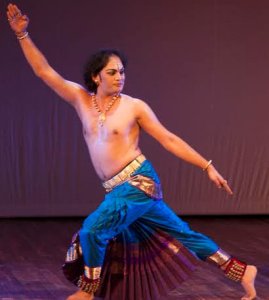 Monojit Saha 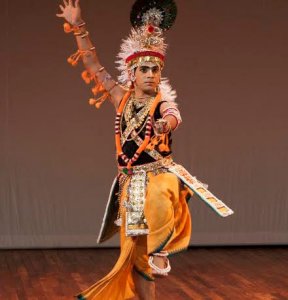 Sudip Ghosh A tall and handsome Monojit Saha (Kolkata) emerged as a dancer holding out promising Bharatanatyam skills, with which he first invoked the all-pervading form of Lord Nataraj and then, in Shivastuti, he went on to portray the benign qualities the Lord represents. As one of a few well-trained and dedicated young male dancers in our country, he left agreeable traits of elasticity and flow of movement. The brilliant dancer remained expressive in varying moods. Sudip Ghosh (Kolkata) was another young male dancer in another classical dance form. The viewers welcomed his relatively rare Krishna Abhisara as part of Basanta Raas, in which the Nayak longingly gets ready at midnight to unite with Radha and other sakhis. He continued with the acute bhakti rasa in Dasavatara, the ten incarnations of Lord Keshav depicted by Balaram. The rich Manipuri aharya with peacock feathers in the headgear and the music lingered in memory. 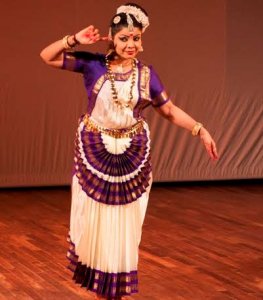 Rekha Raju Rekha Raju (Bangalore), who wears her doctorate in dance and Master’s in management lightly, delectably performed Mohiniattam on Swati Tirunal Bhajan Chaliye kunjanamo and the famous devotional Ashtakam Harivarasanam sung to Lord Ayyappa even as the temple door closes at night. Her body kinetics gracefully carried the mugdha nayika’s bhava in one with ‘Come, Hari, let’s go to the garden…’ and the devotee fondly singing in the other as it were a lullaby to Hari: Sharanam Ayyappa swamy sharanam Ayyappa. Skill and expression  Sannidha Sai Krishna Sannidha Sai Krishna (Vishakhapatnam) from Kuchipudi Kalakshetra, who looked a slip of a girl in age, emerged as a talented dancer exuding graceful confidence. Whether in the initial invocatory piece or in pure nritta later, she remained brilliantly at ease in tune with music and rapport with the appreciative viewers. With what looked like effortless abhivyakti along the lithe flow of movement, reciting words and bols to herself, she was joyously all over the space of her performance area. Uma Dogra’s well-trained disciple Sarita Kalele (UK), who has accompanied her guru in performance and heads her own centre, sought Lord Ganesh’s blessings and proceeded to impressively demonstrate footwork, tihaai, paran and all of pure Kathak quite in sync with the rhythm. For abhinaya, she selected Naa maaro shaama pichakaari. She has admirable technical skill and is understandably confident but didn’t look the traditional bashful Kathak nayika impeccable in taste and subtly expressive. 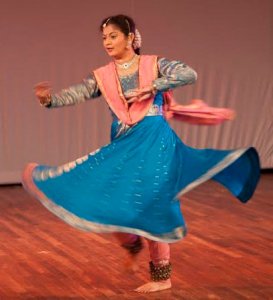 Sarita Kalele  Shivangee Vikram Instead of giving a usual performance, Shivangee Vikram (Ahmedabad) chose to demonstrate the integral connect between the Indian spiritual thought and Bharatanatyam. Following Nrityanjali, with graceful gestures and controlled footwork she sketched in movement the Ganesh-yantra symbols first projected on the backdrop. She pleasingly expressed the individual equipoise anchored within and the balance between Purush and Prakriti in the without. Before concluding with a well-choreographed tillana, she visualized Ashtarasas – shringara, veera, adbhuta among them – as perceived by Parvati in Shiva. 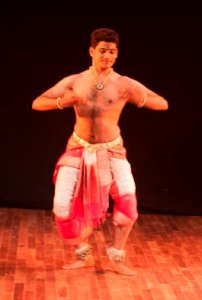 Vidhwan Unnath Following a pleasing Swarnamalika, Vidhwan Unnath in Bharatanatyam style on the third day enacted Krishna lifting Govardhana, a mythological episode not often seen. Against the background of an elegantly well enunciated Darbari Kanada, he helped visualize the endearing form of Lord Krishna with Kastoori tilakam lalaata palake vakshasthale kaustubham … The visual clarity matched the verbal rendering of the narrative concluding with the rains welcome to the cowherd clan and the universe with its birds, animals and open environment. A young Manipuri dancer Bidyananda Singh (Imphal) endeavoured to give glimpses of the devotional ambience of performances in the temple square of his homeland, where Manipuri is part of daily life with Radha’s love for Krishna as narrated to a sakhi. The delicately slow movement remained in harmony with the pleasing slow-paced vocal rendering in a female voice expressing the agony of separation and longing for a union, metaphorically an individual’s desire to be one with the harmony of the universe. 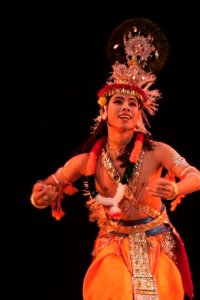 Bidyananda Singh 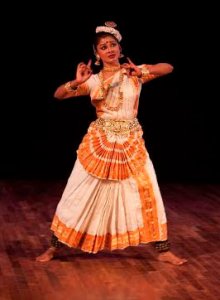 Saji Menon In her Mohiniattam Ganesh invocatory, a short presentation of ‘Varsha’, the metaphoric ‘Kubja’ without the visible hunched back, which finds culmination in ‘Jeev’, Saji Menon (Mumbai) carries the signature of Guru Kanak Rele. It was exhilarating to see the lyrically flowing feminine grace, particularly of the torso, one with the rhythmic patterns, and the abhinaya in varying moods and sentiments. Her ‘Jeev’ was the celebration of the joy of being and feeling the permeating universal ananda with which it longed to be one. The long creative process 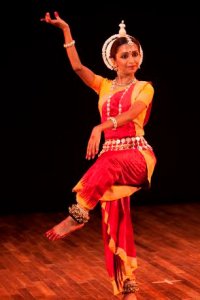 Siddhi Jhuvekar 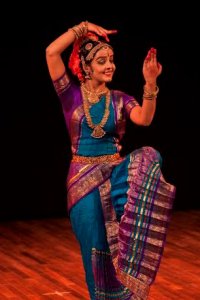 Nirali Shah On day four, Siddhi Jhuvekar’s (Mumbai) Mangalacharana and pure dance Pallavi, both characteristic in Odissi , followed by ‘Celebration of Woman’ with her forms as Goddess Durga, Goddess Saraswati, the earthly Sohini as also Mother, demonstrate her basic training trying to come to terms with the beautiful fourfold bhangas and other body movements for visual expression. She is yet in the process of dropping inhibitions and attaining the expressive lyrical flow with its nuances, which is so special to the form. Mythical references such as what divine beings played the instruments at the time Lord Shiva performed Sandhya Tandava, which Nirali Shah (Ahmedabad) presented in Kuchipudi style, followed by Simhanandini as part of which, besides drawing a lion on a canvas, the dancer demonstrated some of the nuances of Gati, Chari and Karana spelt out in the Natyashastra, help both the dancer and the rasika understand the form better. Over the years, Nirali has developed better expression and is on her way to having a graceful flow in movement. Dimpee Baishya could not turn up for Sattriya dance owing to unavoidable circumstances. 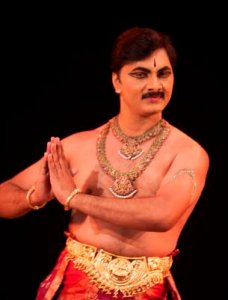 Vijaypal Pathloth Vijaypal Pathloth, a tall Kuchipudi dancer with a modernist demeanour, who interestingly pursues a doctoral study in dance as a therapy, began with Vinayaka Kauthvam and went on to do Tarangam with ease and clarity depicting well-known episodes associated with Krishna’s life, each conveying the idea of a human being in earnest seeking to be part of the element of ananda personified in an endearing divine form. The idea culminated in his dance on a brass plate, always seen to find a popular audience response. Kalamandalam Nimmi’s Mohiniattam performance was marked with the dance form’s characteristic suppleness. She delicately and with warm veneration invoked sarvavighna-naashaka Lord Ganesh followed by cameos of vasakasajja nayika, who longingly prepares for the arrival of her lover, and as kalahanta nayika goes back to the avoidable quarrel she had had with him. She was particularly in her elements when with felicitous mudras she invoked the Lord of Dance in her Shiva Stuti. 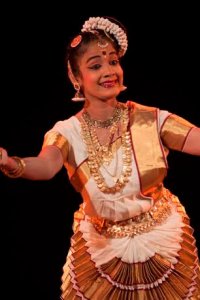 Kalamandalam Nimmi 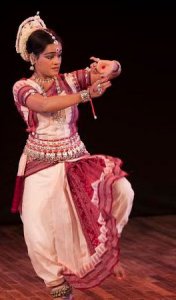 Geetanjali Acharya Offering praises to Lord Jagannath when Geetanjali Acharya did her abhinaya to a clearly enunciated Kede chhanda jana lo sahi …, Banamali’s devotional song on child Krishna with portrayals like the Putana episode, Kaliyamardana and Vishwaroopa Darshan, she emerged as a precocious Odissi dancer capable of all those sinuous moves with the elegant fluidity of a rich flowing river. She brought Kelucharan Mohapatra’s impeccable choreography alive even as preparations were on back home at Srjan for a commemorative tribute to him. Glimpses of spectacle and subtlety 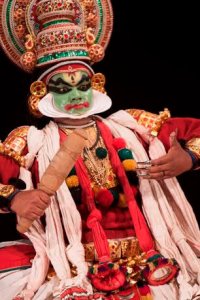 Bajiyo KT The budding Kathakali dancer Bajiyo KT (Thrissur, Kerala) as Bhima in ‘Kalyana Sougandhikam’ from the Mahabharata introduced to the young audience elements of the form to delectable maddalam and chenda sounds. Though the outline announced did give them an idea of the narrative, for them the spectacle of the strong green on the face relieved with thick red lips, dark eyes and eyebrows with an occasional twitch under them, not to mention the kiritam, the gada and the colourful costume, seemed to engage their attention. It is in keeping with the perceived equipoise of Lord Ram as maryada purushottama that Guru Shanta Dhananjayan created the choreography for Uttiya Barua’s (Chennai) ‘Nityopaharam’ with subtly suggestive mudras, facial expression and movement rather than visibly aggressive action and despite a boyish look and a slender frame, the Bharatanatyam dancer rose to expectations. In tune with an expressive verbal recitation, in his visual translation he narrated pretty well episodes based on Jatayu, Surpanakha, Maricha and the like. 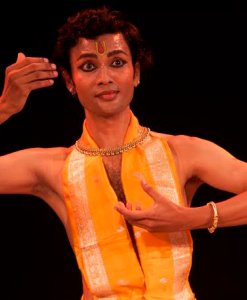 Uttiya Barua 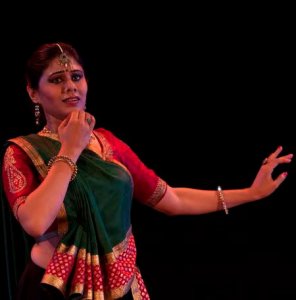 Mahima Pandya Mahima Pandya (Ahmedabad), probably in her maiden public solo performance, joyously concluding the Festival with elements of Kathak, Meera’s Bhajan Mane chaakar rakhoji …, Kesariya Baalam …and Taraana was all flamboyance. In the bhajan, expressively composed and rendered, the choreographers wisely preferred plain gestures and movement to sophisticated expression for the emerging young dancer, who if she takes on subtlety in abhinaya and stamina during the years to come has the potential to become a good dancer. A note of caution Despite a joyous finale, there was no escape from the accumulated impression that the festival ‘Celebrating the World of Dance’ this year did not give a glimpse of the luxuriance of young talents in classical dance we have had in the country. The selection at times did not come up to the standard set during earlier years. When approached, the centers themselves would do well to resist the temptation of participation even with the performer’s rough edges not yet fully rounded off. Dr. SD Desai, a professor of English, has been a Performing Arts Critic for many years. Among the dance journals he has contributed to are Narthaki, Sruti, Nartanam and Attendance. He guest-edited Attendance 2013 Special Issue. His books have been published by Gujarat Sahitya Academy, Oxford University Press and Rupa. After 30 years with a national English daily, he is now a freelance art writer. |